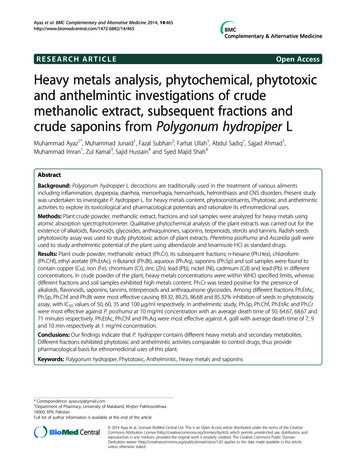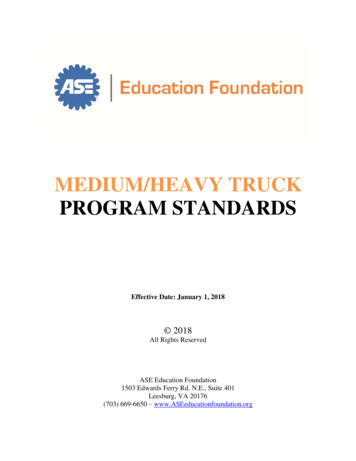
Transcription
Ayaz et al. BMC Complementary and Alternative Medicine 2014, 5RESEARCH ARTICLEOpen AccessHeavy metals analysis, phytochemical, phytotoxicand anthelmintic investigations of crudemethanolic extract, subsequent fractions andcrude saponins from Polygonum hydropiper LMuhammad Ayaz1*, Muhammad Junaid1, Fazal Subhan2, Farhat Ullah1, Abdul Sadiq1, Sajjad Ahmad1,Muhammad Imran1, Zul Kamal3, Sajid Hussain4 and Syed Majid Shah4AbstractBackground: Polygonum hydropiper L decoctions are traditionally used in the treatment of various ailmentsincluding inflammation, dyspepsia, diarrhea, menorrhagia, hemorrhoids, helminthiasis and CNS disorders. Present studywas undertaken to investigate P. hydropiper L. for heavy metals content, phytoconstituents, Phytotoxic and anthelminticactivities to explore its toxicological and pharmacological potentials and rationalize its ethnomedicinal uses.Methods: Plant crude powder, methanolic extract, fractions and soil samples were analyzed for heavy metals usingatomic absorption spectrophotometer. Qualitative phytochemical analysis of the plant extracts was carried out for theexistence of alkaloids, flavonoids, glycosides, anthraquinones, saponins, terpenoids, sterols and tannins. Radish seedsphytotoxicity assay was used to study phytotoxic action of plant extracts. Pheretima posthuma and Ascaridia galli wereused to study anthelmintic potential of the plant using albendazole and levamisole HCl as standard drugs.Results: Plant crude powder, methanolic extract (Ph.Cr), its subsequent fractions; n-hexane (Ph.Hex), chloroform(Ph.Chf), ethyl acetate (Ph.EtAc), n-Butanol (Ph.Bt), aqueous (Ph.Aq), saponins (Ph.Sp) and soil samples were found tocontain copper (Cu), iron (Fe), chromium (Cr), zinc (Zn), lead (Pb), nickel (Ni), cadmium (Cd) and lead (Pb) in differentconcentrations. In crude powder of the plant, heavy metals concentrations were within WHO specified limits, whereasdifferent fractions and soil samples exhibited high metals content. Ph.Cr was tested positive for the presence ofalkaloids, flavonoids, saponins, tannins, triterpenoids and anthraquinone glycosides. Among different fractions Ph.EtAc,Ph.Sp, Ph.Chf and Ph.Bt were most effective causing 89.32, 89.25, 86.68 and 85.32% inhibition of seeds in phytotoxicityassay, with IC50 values of 50, 60, 35 and 100 μg/ml respectively. In anthelmintic study, Ph.Sp, Ph.Chf, Ph.EtAc and Ph.Crwere most effective against P. posthuma at 10 mg/ml concentration with an average death time of 50, 64.67, 68.67 and71 minutes respectively. Ph.EtAc, Ph.Chf and Ph.Aq were most effective against A. galli with average death time of 7, 9and 10 min respectively at 1 mg/ml concentration.Conclusions: Our findings indicate that P. hydropiper contains different heavy metals and secondary metabolites.Different fractions exhibited phytotoxic and anthelmintic activites comparable to control drugs, thus providepharmacological basis for ethnomedicinal uses of this plant.Keywords: Polygonum hydropiper, Phytotoxic, Anthelmintic, Heavy metals and saponins* Correspondence: ayazuop@gmail.com1Department of Pharmacy, University of Malakand, Khyber Pakhtoonkhwa18000, KPK, PakistanFull list of author information is available at the end of the article 2014 Ayaz et al.; licensee BioMed Central Ltd. This is an Open Access article distributed under the terms of the CreativeCommons Attribution License (http://creativecommons.org/licenses/by/4.0), which permits unrestricted use, distribution, andreproduction in any medium, provided the original work is properly credited. The Creative Commons Public DomainDedication waiver ) applies to the data made available in this article,unless otherwise stated.
Ayaz et al. BMC Complementary and Alternative Medicine 2014, 5Page 2 of 9BackgroundPakistan is naturally gifted with a wide variety of medicinalplants due to its diverse climate and edaphic conditions.At least six thousand flowering plants have been reportedcurrently from Pakistan among which 400–600 are of highmedicinal value [1]. Even though a large number of clinically effective drugs have been developed, indigenous phytotherapy is still practiced in several developing countries[2]. About 85% of primary health care medications are obtained from natural sources worldwide [3]. It is desirableto utilize the therapeutic potential of higher plants to getnovel, affordable, more effective and safer natural drugs.Polygonum hydropiper, also known as “smartweed” belong to Polygonaceae, a family comprising of about 50genera and 1200 species [4]. Domestically the plant is usedas anti-inflammatory, carminative, astringent, diuretic,CNS stimulant, diaphoretic, stomachic, emmenagogue,anthelmintic, in bleeding disorders and in diarrhea [5].Conventionally, the whole plant decoction is used to treatdifferent diseases like dyspepsia, menorrhagia, hemorrhoids, and skin itching [6]. Ethnomedicinally P. hydropiper and other species of Polygonaceae are used to treatfever, chill, joint pain, oedema and infectious diseases formore than 300 years in Chinese folk medicine [7]. Moreover it is also used to treat rheumatoid arthritis [8], Prostategland inflammation, diarrhea [9], insomnia, kidney diseases,hemorrhoids [10], hypertension, angina and other cardiovascular diseases [11,12]. We recently reported P. hydropiper for antioxidant, anticholinestrase activities and itspotential use in the treatment of neurodegenerative diseases[13]. Other species of Polygonaceae including Polygonumpersicaria and Polygonum plebejum are reported for cytotoxic and phytotoxic activities [14].Though plant based therapies are known to be free fromside effects in comparison to allopathic drugs, still thepresence of toxic heavy metals in such products can causeserious health consequences [15,16]. Recent scientific research has revealed that several plants used as food or intraditional medicine are potentially toxic, mutagenic andcarcinogenic [17,18]. World Health Organization (WHO)recommends that such products must be evaluated for theextent of heavy metals prior to use in human beings.Phytochemicals are broadly grouped into two categories namely, primary constituents and secondary metabolites. Primary constituents include amino acids, proteins,common sugars and chlorophyll whereas secondary constituents include alkaloids, phenolic compounds, flavonoids, saponins, essential oils, tannins and terpenoids [19].Majority of phytochemicals have been known to bear valuable therapeutic activities and the plants thus find theirmedicinal value due to respective phytochmical constituents they contain. Saponins, glycosides widely distributedin the plants kingdom, consist of a diverse group of compounds characterized by their structure containing asteroidal aglycone and one or more sugar chains. Theirstructural diversity is reflected in their physicochemical andbiological properties, which are exploited in a number oftraditional, industrial [20] and pharmacological uses including, antimicrobial, antidiabetic, cytotoxic, antispasmodic,antioxidant, antineoplastic and anthelmintic [21-25].Globally there are two billion people of different ageswhich are parasitic worms carriers [26]. These helminthescause malnutrition, malabsorption, iron-deficiency anemiaand obstruction of small intestine which leads to impairment in physical growth cognitive and intellectual potential of children [27,28]. Thus treatment of individualinfected patients and awareness in the community is veryimportant [29]. Beside this, helminthiasis is a common animals disease in developing countries, leading to reductionin the production of milk [30]. The development of novelanthelmintic drugs is not very rapid in the developingcountries due to less financial benefits in comparison toinvestment. Beside this, emergence of helminthes resistance against anthelmintic drugs [31] has led to the proposal of screening medicinal plants for their anthelminticactivity. So there is need to develop new, cost-effectivedrugs for the treatment of parasitic infections [32]. Plantsare potential sources of anthelmintic drugs and a varietyof medicinal plants have been employed to treat parasiticinfections in man and animals [33,34]. Heavy metals aretoxic for human beings and are also phytotoxic in nature.Thus aims of the current study were heavy metals analysisin different fractions and their relation with phytotoxicity.Further we also investigated secondary metabolites andantelmintic potential of P.hydropiper extracts and crudesaponins.MethodsChemicals and drugsAlbendazole and Levamisole HCl used as standarddrugs in anthelmintic activity were purchased fromGlaxoSmithKline and ICI Pakistan respectively. Paraquat(Sigma-Aldrich EC 231-791-2) was used as positive control in phytotoxic assay. Solvents used in extraction,metals analysis and reagents for phytochemical tests wereof pure analytical grade.Plant material, extraction and fractionationP. hydropiper whole plant was collected from Talash Valley,Khyber Pakhtoonkhwa Pakistan in July, 2013 and was identified by Dr. Gul Rahim, Arid Agriculture University,Rawalpindi, Pakistan. A voucher (H.UOM.BG.107) of thespecimen was deposited at the herbarium of University ofMalakand, Chakdara (Dir), Pakistan. Plant material wascleansed with distilled water and was shade dried for30 days. Thereafter, it was coarsely crushed using cuttermill. The powder material (4.5 kg) was soaked in 80%methanol (22 L) in large container for 15 days with
Ayaz et al. BMC Complementary and Alternative Medicine 2014, 5Page 3 of 9frequent shaking. Extraction with methanol was repeatedthree times, added to original extract and filtered throughmuslin cloth and then through filter paper [35]. The filtratewas concentrated using rotary evaporator (Heidolph Laborota 4000, Schwabach, Germany) under reduced pressure at40 C resulting in 290 g (6.44%) of dark brown semisolidmass. Crude methanolic extract (250 g) of P. hydropiper(Ph-Cr) was suspended in 500 ml of distilled water andconsequently partitioned with n-hexane (3 500 ml),chloroform (3 500 ml), ethyl acetate (3 500 ml), n-butanol (3 500 ml) and finally aqueous fraction was left. Extraction yield were 68 g (27.2%) for Ph.Hex, 27 g (10.8%)for Ph.Chf, 13 g (5.2%) for Ph.EtAc, 11 g (4.4%) for Ph.Bt &37 g (14.8%) for Ph.Aq fractions.detection of steroids and triterpenoids. Briefly Ph.Cr wasmixed with few drops of acetic anhydride followed by boiling and cooling. Concentrated H2SO4 was then added fromthe sides of the test tube and was observed for the formation of a brown ring at the junction of two layers. Formation of green color at the upper layer and deep red color atthe lower layer indicate presence of steroids and triterpenoids respectively. For the detection of glycosides “KellerKilliani” Test was used. Test solution was added a fewdrops of glacial acetic acid and Ferric chloride solution andwere properly mixed. A few drops of concentrated H2SO4were added to this mixture and observed for the formationof two layers. Lower reddish brown layer and upper aceticacid layer which turns bluish green indicates positive testfor glycosides. Presence of saponins was detected based onthe formation of froth upon vigorous shaking using dilutedsamples. Anthraquinones were detected by boiling the testsample with 1 ml of H2SO4 in a test tube followed by filtration. After cooling the filtrate was shacked with equalvolume of chloroform and lower layer was separated andshacked with dilute ammonia. Formation of rose pink tored color ammonical layer indicate presence of anthraquinone glycosides. Ph.Cr was treated with gelatin solution and the appearance of white precipitate was observedwhich indicate the presence of tannins.Extraction of crude saponinsPlant material (powdered) weighing 60 g was transferredto a conical flask and was soaked with 100 ml of 20%ethanol. The mixture was heated for 4 h at 55 C usingwater bath and constant shaking. Thereafter, it was filtered and was again extracted with 200 ml of 20% ethanol. Volume of the liquid extracted was reduced to40 ml using water bath and transferred it to a separatingfunnel. Diethyl ether (20 ml) was added to it with vigorousshaking to separate the two phases (Diethyl ether andwater). Organic layer was discarded, whereas 60 ml of nbutanol was added to aqueous fraction. The combinedaqueous - butanol mixture was washed two times with 5%NaCl solution. Finally solvents were evaporated using waterbath to get saponins (9 g) with a percent yield of 15% [36].Metals analysisFor metal analysis chemicals of analytical grade wereused to prepare sample of the crude drug and differentfractions. From each fraction a sample weighing 2 g wastaken in a crucible and was ignited in a muffle furnaceat 550 C for 6 h. The ash produced was digested in 5 mlof concentrated nitric acid followed by evaporation on hotplate. Small amount of distilled water was added to thedigested residue, filtered and volume was made to 30 mlusing distilled water. The solutions formed were quantitatively analyzed using atomic absorption spectrophotometer (model 1100; Perkin Elmer, Waltham, Massachusetts,USA) for the heavy metals including, iron (Fe), lead (Pb),copper (Cu), cadmium (Cd), zinc (Zn), nickel (Ni) andchromium (Cr) [37].Phytochemical investigationQualitative phytochemical analysis of the plant extracts wascarried out for the existence of alkaloids, flavonoids, glycosides, anthraquinones, saponins, terpenoids, sterols andtannins using the method reported previously [38]. Thepresence of alkaloids was determined using Dragendorff’sreagent. Liebermann Burchard test was used for thePhytotoxicity assayRadish seeds were used to study phytotoxic potential ofplant extracts employing method previously described[39]. Mercuric chloride (HgCl2) 0.1% solution was prepared in distilled water and radish seeds were put in itto be surface sterilized for 2–3 minutes. The seeds wererinsed with autoclaved distilled water and were driedusing sterilized blotting paper. 0.5 ml of each sample solution was transferred to sterilized Petri dish containingWhatman paper and methanol was vacuum evaporated.Methanol (5 ml per Petri dish) was used as negative control (blank). To each test group Petri dish 5 ml of distilled water was added, and 25 radish seeds were placedin each plate at sufficient distance using sterilized forceps. All plates were incubated at 25 C in dim light.After 3–5 days of incubation, number of seeds germination and percent inhibition of root length was calculated using formula:% inhibition of the root length ¼Root lengthin test sample 100Root length in controlThe test was performed in triplicate and data were analyzed by ANOVA.Anthelmintic assayAdult earthworms (Pheretima posthuma L. Vaill) androundworms (Ascaridia galli) were used to investigateanthelmintic potential of Ph.Cr, Ph.Hex, Ph.Chf, Ph.
Ayaz et al. BMC Complementary and Alternative Medicine 2014, 5Page 4 of 9EtAc, Ph.Bt, Ph.Aq and Ph.Sp using method previouslydescribed [40]. Earthworms were selected for in-vitro investigation due to their high physiological and anatomical resemblance with human intestinal roundwormAscaris lumbricoides [33,34]. The earth worms were collected from marshy soil having small pellets on the surface in the locality of University of Malakand, ChakdaraKhyber Pakhtoonkhwa, Pakistan, with an average lengthof 8-9 cm. For collection of round worms intestines offreshly slaughtered fowls were dissected and were maintained in normal saline solution. average length ofroundworms was 5-7 cm. Different dilutions (1, 5 and10 mg/ml) of plant extracts, Ph.Sp and standard drugs(albendazole and levamisole HCl) were prepared. Fromthese solutions, 25 ml each were transferred to sterilePetri dishes and six worms were added to each Petri dishwith the help of spatula. Time for complete paralysis ofthe worms, when no movement (except with vigorousshaking) was observed. Similarly, death time was notedwhen no movement was observed even with vigorousshaking and exposure to hot water at 50 C temperature.1.51 0.45, 7 0.06, 0.35 0.154 and 0.199 0.001 ppmwhile the concentration of Pb in crude powder was belowthe detectable range. On the other hand, concentrations ofthese metals were high in soil samples as compared withthe Ph.Cr and different fractions extracted from crude extract. Cr concentration was below detection limit in almost all fractions except Ph.Cr.Statistical analysisOne-way ANOVA followed by Dunnett’s multiple comparison test were applied for the comparison of positivecontrol with the test groups. P values less than or equalto 0.05 were considered statistically significant. GraphPad Prism and XL sheet were used to draw the curvesand IC50 values. The standard error of mean (SEM) werecalculated at 95% confidence intervals.Phytochemical analysisPh.Cr was tested positive for the presence of alkaloids,flavonoids, saponins, tannins, triterpenoids anthraquinones, glycosides, while tested negative for the presenceof steroids (Table 2).Phytotoxic assayThe crude extract and its fractions showed concentrationdependent phytotoxicity. Regarding seeds inhibition, Ph.Chf, Ph.EtAc and Ph.Sp were most potent causing 86.68 3.5%, 89.32 4.8% and 89.25 2.2% inhibitory effects onseeds germination at 1 mg/ml concentration with IC50values of 35, 50 and 60 μg/ml, respectively. This wasfollowed by Ph.Cr, Ph.Hex, Ph.Bt and Ph.Aq fractionswhich showed 68.00 2.8% (IC50 310 μg/ml), 77.32 1.3%(IC50 215 μg/ml), 85.32 3.5% (IC50 100 μg/ml), 73.32 3.5% (IC50 485 μg/ml) inhibition of seed germination respectively at 1 mg/ml concentration. Ph.Bt, Ph.Sp, Ph.EtAcand Ph.Cr showed highest inhibitory effect on root lengthcausing 86.26 1.25% (IC50 8 μg/ml), 91.90 0.75% (IC5010 μg/ml), 92.34 1.30% (IC50 11 μg/ml) and 82.38 0.68% (IC50 11 μg/ml) respectively, at 1 mg/ml concentration (Table 3).ResultsMetals analysisAnthelmintic assayThe concentrations of various metals in dry powder, Ph.Cr and different fractions i.e. Ph.Hex, Ph.Chf, Ph.EtAc,Ph.Bt, Ph.Aq, Ph.Sp of P. hydropiper are summarized inTable 1. Results indicate that in crude powder of P.hydropiper, concentrations of all heavy metals includingCu, Fe, Cr, Zn, Ni and Cd were 7.21 0.23, 95.00 0.55,Results of P. hydropiper anthelmintic activity against P.posthuma and A.galli are given in Figures 1(a,b) and 2(a,b). Among different fractions Ph.Sp, Ph.Chf, Ph.Bt andPh.EtAc were most effective against P. posthuma with deathtime of 50.00 0.75, 64.67 2.51, 66.33 1.53 and 68.67 1.52 minutes respectively at 10 mg/ml concentration.Table 1 Metal contents (ppm) in crude powder, soil and different fractions of P. hydropiperSampleCuFeCrZnNiCdPbCrude Powder7.21 0.2395.00 0.551.51 0.457 0.060.199 0.0010.35 0.154NdPh.Cr41.16 0.0610.89 0.001243.12 0.31NdNd22.85 0.0579.37 1.47Ph.Hex45.96 0.0776.15 0.27Nd4.32 0.00911.45 0.0220.28 0.0267.30 0.31Ph.Chf134.70 0.15155.88 0.21NdNd7.05 0.0116.02 0.1155.44 2.03Ph.EtAc25.60 0.2526.55 0.09NdNd9.56 0.089.55 0.02NdPh.Bt51.40 0.03135 0.70Nd28.28 0.01Nd37.1 0.01370.3 1.57Ph.Aq34.60 0.05124.65 0.04Nd139.92 0.002Nd23.18 0.02NdSoil125.30 0.50113 1.5476.95 0.5989.34 0.4619 1.2555.23 1.0590.15 0.56Cu: copper; Fe: iron; Cr: chromium; Zn: zinc; Pb: lead; Ni: nickel Cd: cadmium; Pb: lead.Nd: Not detected/ below detectable concentrations.
Ayaz et al. BMC Complementary and Alternative Medicine 2014, 5Page 5 of 9Table 2 Phytochemical constituents in crude extract of P. hydropiperS. noPhytochemical classTest ��s TestTurbidity/precipitation 2FlavonoidsFerric chloride testFormation of yellow color which changed to colorless on acid addition 3SaponinsFroth Test1. Stable froth formation 2. Emulsion formation after olive oil 4TanninsGelatin Testappearance of white precipitate 5SteroidsLiebermann Burchard testgreen to pink color was absent-6GlycosidesKeller KillianiLower reddish brown layer & upper acetic acid layer which turns bluish green 7AnthraquinonesBontrager’s testFormation of red, violet or pink color f in aqueous layer 8TriterpenoidsLiebermann Burchard testAppearance of reddish brown-deep red color ; Phytoconstituent present -; Phytoconstituent Absent.Table 3 Phytotoxic effect of the crude extract, subsequent fractions and crude saponins of P. hydropiper against radishseedsSamplesConc.mg/mlAverage root length(mm) mean SEMAverage no of seedsinhibited mean SEMRoot length inhibition% mean SEMIC50 μg/mlSeeds inhibition% mean SEMIC50μg/mlPh.Cr10005.13 0.2017.00 0.5882.38 0.68***1668.00 2.8***3105006.87 0.2614.66 0.8976.41 0.89***58.64 3.5***2508.23 0.2011.33 0.8971.74 0.68***45.32 2.8***10005.33 0.4919.33 0.3382.70 1.6***5005.03 0.2317.33 0.6781.73 0.78***25012.03 0.4812.33 0.6758.70 1.60***49.32 2.7***10003.9 0.5221.67 0.8986.61 1.70***86.68 3.5***5008.4 0.3319.00 1.1571.16 1.10***25011.3 0.4318.00 0.0061.20 1.40***10002.23 0.4022.33 1.2092.34 1.30ns5004.9 0.4321.66 1.2083.17 1.40***Ph.HexPh.ChfPh.EtAcPh.BtPh.AqPh.SpPositive controlNegative control77.32 1.3***12414569.32 2.7***76.00 4.6***2153572.00 0.0***89.32 4.8***1185.32 4.8ns2505.9 0.2017.67 0.8979.74 0.68*70.68 3.5***10004.0 0.3721.33 0.8986.26 1.25***85.32 3.5***5005.93 0.4918.00 0.5879.64 1.60***2507.03 0.2316.00 0.0075.86 0.78***10006.2 0.2318.33 0.8978.71 0.78***5008.8 0.3712.67 0.8969.79 1.20***25012.9 0.4807.00 1.1555.71 1.60***28.00 4.6***10005.00 0.5022. 00 1.1091.90 0.75 ns89.25 2.2***5007.25 0.2019.00 1.5082.10 1.50***2508.50 0.5817.00 0.8979.74 0.68*10001.93 0.4924.67 0.8993.64 1.605003.03 0.2322.16 1.1089.20 1.402505.71 0.7821.90 0.5283.33 1.20———29.13 0.37—————872.00 0.0***5010064.00 0.0***73.32 3.5***1701050.68 3.5***77.25 1.0***4856070.68 1.5***98.61 1.700.8988.22 0.230.8987.93 0.49——————Standard drug (P. Control) Paraquat IC50 0.89 μg/ml. Results expressed as average seeds inhibition, % inhibition and Inhibition of root length (mean SEM n 3)and IC50. Values significantly different as compare to Standard drug; *P 0.05, *** P 0.001.
Ayaz et al. BMC Complementary and Alternative Medicine 2014, 5a40****35Paralysis time in minutesPage 6 of eLevamisole HCl30*****25*****20*1510501 5 10 1 5 10 1 5 10 1 5 10 1 5 10 1 5 10 1 5 10 1 5 10 1 5 10Concentrations (mg/mL)b 10090Death time in dazoleLevamisole HCl******60***504030201001 5 10 1 5 10 1 5 10 1 5 10 1 5 10 1 5 10 1 5 10 1 5 10 1 5 10Concentrations (mg/mL)Figure 1 Anthelmintic activity of Ph.Cr, subsequent fractions and Ph.Sp of P. hydropiper against P. posthuma (a: Paralysis timeb: Death time in minutes).Whereas the death times of P. posthuma against standarddrugs albendazole and levamisole HCl were 29.33 1.54and 31.33 2.08 minutes, respectively, at 10 mg/ml concentration. Death time for Ph.Cr, Ph.Hex, Ph.Aq were 71.00 1.73, 74.67 1.52 and 81.67 0.57 minutes, respectively, at10 mg/ml concentration. Paralysis time for different fractions against P. posthuma were; Ph.Cr (17.00 1.00), Ph.Hex (21.00 3.00), Ph.Chf (9.67 2.51), Ph.EtAc (12.67 0.57), Ph.Bt (8.33 1.53), Ph.Aq (22.67 2.51) and Ph.Sp(11.00 0.58) minutes. While for albendazole and leva-misole HCl the paralysis times were 7.67 0.57 and8.33 0.58 minutes respectively at 10 mg/ml concentration. In anthelmintic activity against A. galli, Ph.EtAc, Ph.Chf and Ph.Aq were most effective with average death timeof 7, 9 and 10 minutes respectively at 1 mg/ml concentration. Activity of these fractions were comparable to controldrugs albendazole and levamisole HCl which killed alltested roundworms in 10 and 9 minutes respectively at thesame concentration. All other fractions were effective inconcentration dependent manner (Figure 2a,b).
Ayaz et al. BMC Complementary and Alternative Medicine 2014, 5a30Page 7 of 9***Paralysis time in h.ChfPh.EtAcPh.BtPh.AqPh.SpAlbendazoleLevamisole HCl01 5 10 1 5 10 1 5 10 1 5 10 1 5 10 1 5 10 1 5 10 1 5 10 1 5 10Samples concnetration (mg/ml)b40Death time in fPh.EtAcPh.BtPh.AqPh.SpAlbendazoleLevamisole HCl01 5 10 1 5 10 1 5 10 1 5 10 1 5 10 1 5 10 1 5 10 1 5 10 1 5 10Samples concnetration (mg/ml)Figure 2 Anthelmintic activity Ph.Cr, subsequent fractions and Ph.Sp of P. hydropiper against Ascaridia galli (a: Paralysis time b: Deathtime in minutes).DiscussionHigh levels of heavy metals, like lead, cadmium, chromium and manganese which are present in soil andwaste water utilized for agricultural irrigation, can be accumulated into these systems. Because of their nonbiodegradability features, toxicity effects onto severalcrops and consequently their bioavailability in humanbeings may be hazardous. Presence of heavy metals andtheir interactions with essential trace elements can causeserious health consequences. WHO recommends thatplant materials, which are used to make finished products for use, may be checked for the occurrence of heavymetals contamination. Pb and Cd are non-essential traceelements having no useful function in the body. Pb poisoning causes convulsions, chronic nephritis, centralnervous system disorders and colic whereas Cd afterchronic accumulation in the body causes liver and kidneydamages. The consequences of chronic Cr intake includeskin rash, nasal itch, kidney and liver damage, bleeds,stomach upsets and lungs cancer [41]. According toWHO, the specific limit of heavy metals Pb, Cd, Cr, Cu,Ni and Zn in medicinal plants and food are 10, 1, 1.5, 10,1.5 and 50 ppm, respectively [42,43]. In the present study,we observed that crude powder of P. hydropiper containsthe aforementioned metals in lower concentrations thanthe permissibility. But the levels of heavy metals particularly Pb, Cd and Cr were high in different fractions. Asfractions are extracted from greater quantity (Kg) of crudepowder so high concentrations of these metals are concentrated in these fractions. High concentrations of thesemetals can be attributed to their concentration in the soiland marshy place from where the plant was collected.
Ayaz et al. BMC Complementary and Alternative Medicine 2014, 5Different weeds are amongst the most key factorsresponsible for significant reduction in crops yield. InSindh and Punjab provinces of Pakistan almost fortyweed species have been reported which account forabout 40% loss in wheat crop yield on the average.To counteract these unwanted weeds different chemicals are used. However, such chemicals are frequentlyassociated with environmental pollution, residual toxicity, carcinogenesis, high cost and hence their use isrestricted [42,44]. Consequently, the search for alternative herbicides which are safe and cost-effective isneeded. Natural herbicides may be among these alternatives. In the current phytotoxic assay, Ph.Chf wasmost potent and it is also obvious from the resultsthat this fraction contain high concentration of heavymetals. So it may be deduced that the greater heavymetals content may be a reason for high phytotoxicactivity of Ph.Chf. It is also revealed from the datathat P.hydropiper could be a significant source of natural herbicides for weeds control in a sustainablemanner to increase per acre yield.Anthelmintic drugs are losing their efficacy due to resistance of different nematodes to these drugs especially asa single dose regimen [45]. Widespread efforts have beenmade to find out more effective and safe anthelminticdrugs. Plant extracts and crude saponins are potentialsources of anthelmintic drugs and have been extensivelystudied for anthelmintic activities [21,34]. Results of ouranthelmintic investigation against P. posthuma and A. galliare mentioned in Figures 1(a,b) and 2(a,b). All fractionsshowed dose dependent response against the tested parasites. The data revealed that Ph.Sp, Ph.Bt, Ph.Chf and Ph.EtAc exhibited significant anthelmintic activity against P.posthuma at 10 mg/ml concentration. Whereas Ph.EtAc,Ph.Chf and Ph.Aq were most effective against A. galli.Anthelmintic activities of these fractions were comparableto positive control drugs (albendazole and levamisoleHCl) at the same concentration.ConclusionsThis study reveals that P. hydropiper contain Fe, Pb,Cu, Cd, Zn, Cr, Co, secondary metabolites like; alkaloids alkaloids, flavonoids, saponins, tannins, terpenoids, anthraquinones and glycosides. The plant crudeextract, its various fractions and crude saponins exhibited concentration dependent phytotoxic and anthelmintic actions, and therefore may be excellentsources of phytotoxic and anthelmintic constituentsthat warrant their isolation and purification. Furtherinvestigations including activity guided isolation is inprogress in our laboratory.Competing interestThe authors declare that they have no competing interest.Page 8 of 9Authors’ contributionsMA and SA carried out experimental work, data collection and evaluation,literature search and manuscript preparation. MJ and FU supervised researchwork and helped in study design. FS provided guidance during study designand experiments. AS, MI, SH, SMS, and ZK refined the manuscript forpublication. All authors read and approved the final manuscript for publication.Acknowledgeme
USA) for the heavy metals including, iron (Fe), lead (Pb), copper (Cu), cadmium (Cd), zinc (Zn), nickel (Ni) and chromium (Cr) [37]. Phytochemical investigation Qualitative phytochemical analysis of the plant extracts was carried out for the existence of alkaloids, flavonoids, glyco-sides, anthraquinones, saponins, terpenoids, sterols and











